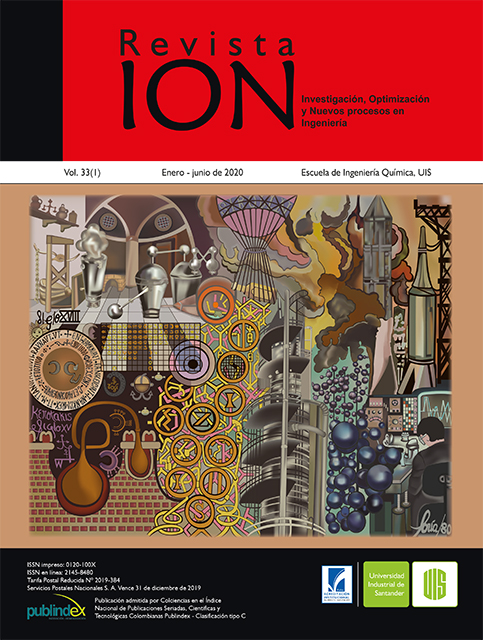Microencapsulation of oils with high content of fatty acids using the spray-drying method
Published 2020-06-30
Keywords
- Microencapsulation,
- Spray Drying,
- Olive Oil,
- Almond Oil,
- Release Rates
- Maltodextrin ...More
How to Cite
Abstract
Currently, development of new food products that incorporate active ingredients has become a crucial factor for food industries to successfully compete in the market, providing solutions to existing and future needs of their customers. Microencapsulation is presented as a novel alternative to generate products with added value, since it allows avoiding degradation of active compounds, as well as unpleasant changes in taste, especially in case of essential oils. Microencapsulation of olive oil and almond oil was studied from an emulsion formulation to produce microcapsules that were subsequently obtained by spray drying method in a Minispray Dryer B-290. Morphology, percentage of encapsulated oil and release rates within the human body were analyzed. The results obtained made it possible to determine that it is possible to encapsulate essential oils by the spray-drying method. This allows to prevent degradation of fatty acids in oil storage and gastric digestion, as well as to deliver them straight to small intestine. Furthermore, an oil with a higher percentage of fatty acids increases agglomeration tendency of microcapsules. Lastly, it was found that microcapsules with maltodextrin as wall material can retain a greater amount of almond oil than olive oil.
Downloads
References
[2] Lin J. Innovation in Low-Tech Industries An Example of the Food Industry in China. Switzerland: Lund University; 2017.
[3] McClements DJ. Food Emulsions: Principles, Practices, and Techniques. 3 ed. Estados Unidos: CRC Press; 2015.
[4] Vieira SA, Zhang G, Decker EA. Biological Implications of Lipid Oxidation Products. J. Am. Oil Chem. Soc. 2017;94(3):339-51.
[5] Zárate R, el Jaber-Vazdekis N, Tejera N, Pérez JA, Rodríguez C. Significance of long chain polyunsaturated fatty acids in human health. Clin Transl Med. 2017;6(1):25.
[6] Perez R, Gaonkar AG. Commercial Applications of Microencápsulation and Controlled Delivery in Food and Beverage Products. Elsevier Inc. 2014;543–9.
[7] Jafari SM. An overview of nanoencápsulation techniques and their classification. Elsevier Inc. 2017;1–34.
[8] Ozkan G, Franco P, De Marco I, Xiao J, Capanoglu E. A review of microencápsulation methods for food antioxidants: Principles, advantages, drawbacks and applications. Food Chem. 2019;272:494–506.
[9] Rowe DJ, David J. Chemistry and Technology of Flavors and Fragrances. United Kingdom: Blackwell Publishing Ltd; 2005.
[10] Gregory EN. Selection of Materials for Hardfacing. United Kingdom: Welding Institute; 1980.
[11] Dokic-Baucal L, Dokic P, Jakovljevic J. Influence of different maltodextrins on properties of O/W emulsions. Food Hydrocoll. 2004;18(2):233–39.
[12] Dokic PP, Dokic-Baucal LP, Sovilj JV, Katona JM. Influence of maltodextrin dextrose equivalent value on rheological and dispersion properties of sunflower oil in water emulsions. Acta Period. Technol. 2004;(35):17-24.
[13] García-Inza GP, Castro DN, Hall AJ, Rousseaux MC. Responses to temperature of fruit dry weight, oil concentration, and oil fatty acid composition in olive (Olea europaea L. var. ‘Arauco’). Eur. J. Agron. 2014;54:107-15.
[14] Rosani L. Desenvolvimiento e estudo da estabilidade de nanoemulsoes do tipo oleo em agua com oleos vegetais. Brasil: UFSCar; 2011;
[15] Fritsche C, Koller E. Büchi Mini Spray Dryer B-290-User Manual. Switzerland: Büchi Labortechnik AG; 2009.
[16] Eratte D, Dowling K, Barrow CJ, Adhikari BP. In-vitro digestion of probiotic bacteria and omega-3 oil co-microencápsulated in whey protein isolate-gum Arabic complex coacervates. Food Chem. 2017;227:129–36.
[17] Muñoz LZ, Narvárez CG. pH Salival, Capacidad Buffer, Proteínas Totales y Flujo Salival en Pacientes Hipertensos Controlados Usuarios de Diuréticos. Int. J. Odontostomat 2012;6(1):11–7.
[18] Maurer JM, Schellekens RCA, Rieke HMV, Wanke C, Zee D, Woerdenbag HJ, et al. Gastrointestinal pH and Transit Time Profiling in Healthy Volunteers Using the IntelliCap System Confirms Ileo-Colonic Release of ColoPulse Tablets. PLoS ONE. 2015;10(7):1–17.
[19] Romero-Segura C, Sanz C, Perez AG. Purification and Characterization of an Olive Fruit β-Glucosidase Involved in the Biosynthesis of Virgin Olive Oil Phenolics. J Agric Food Chem. 9 de septiembre de 2009;57(17):7983-8.
[20] Malhotra P, Dey PM. Purification and Physical Properties of Sweet-Almond. Biochem J.1967;103(2):508-13.
[21] Marques GR, Birchal VS, Borges SV, Botrel DA, Campelo Felix PH. Physicochemical and thermal stability of microcapsules of cinnamon essential oil by spray drying. J Food Process Pres. 2016;41(3):1-9.
[22] Sobel R, Khare A, Vasisht N, Gaonkar AG. Microencápsulation in the Food Industry. Netherlands: Elsevier Inc; 2014.
[23] Chen C-Y, Lee Y-H, Chang S-H, Tsai Y-F, Fang J-Y, Hwang T-L. Oleic acid-loaded nanostructured lipid carrier inhibits neutrophil activities in the presence of albumin and alleviates skin inflammation. Int J Nanomedicine. 2019;(14):6539-53.
[24] Yamashoji S, Yoshida H, Kajimoto G. Photooxidation of Linoleic Acid by Ultraviolet Light and Effect of Superoxide Anion Quencher. Agric Biol Chem. 1979;43(6):1249-54.


